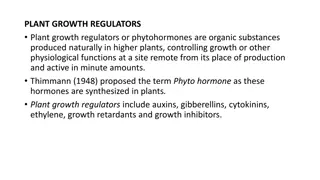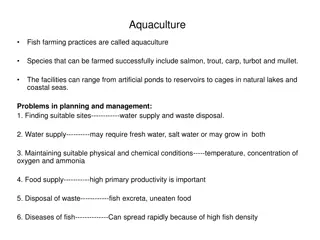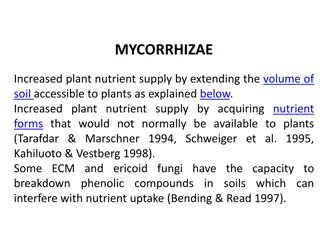Organic Farming: Preparation of Panchagavya for Plant Growth
Panchagavya, an organic product made from cow dung, urine, milk, and other ingredients, is a potent solution for promoting plant growth and immunity. Learn how to prepare and apply it effectively in agriculture, its physico-chemical properties, recommended dosage for various applications, and the ideal time for its application on different crops.
Download Presentation

Please find below an Image/Link to download the presentation.
The content on the website is provided AS IS for your information and personal use only. It may not be sold, licensed, or shared on other websites without obtaining consent from the author. Download presentation by click this link. If you encounter any issues during the download, it is possible that the publisher has removed the file from their server.
E N D
Presentation Transcript
Center for Smart Agriculture Organic Farming Module 2: Preparation and application of organic inputs Session 8: Preparation of panchagavya
Preparation of Panchagavya Panchagavya, an organic product has the potential to play the role of promoting growth and providing immunity in plant system. Panchagavya consists of nine products viz. cow dung, cow urine, milk, curd, jaggery, ghee, banana, Tender coconut and water. When suitably mixed and used, these have miraculous effects. Cow dung - 7 kg Cow ghee - 1 kg Mix the above two ingredients thoroughly both in morning and evening hours and keep it for 3 days Cow Urine - 10 liters Water - 10 liters After 3 days mix cow urine and water and keep it for 15 days with regular mixing both in morning and evening hours. After 15 days mix the following and panchagavya will be ready after 30 days. Cow milk - 3 liters Cow curd - 2 liters Tender coconut water - 3 liters Jaggery - 3 kg Well ripened poovan banana 12 nos
All the above items can be added to a wide mouthed mud pot, concrete tank or plastic can as per the above order. The container should be kept open under shade. The content is to be stirred twice a day both in morning and evening. The Panchagavya stock solution will be ready after 30 days. (Care should be taken not to mix buffalo products. The products of local breeds of cow is said to have potency than exotic breeds). It should be kept in the shade and covered with a wire mesh or plastic mosquito net to prevent houseflies from laying eggs and the formation of maggots in the solution. If sugarcane juice is not available add 500 g of jaggery dissolved in 3 liter of water.
Physico-chemical properties of Panchagavya revealed that they possess almost all the major nutrients, micro nutrients and growth harmones (IAA & GA) required for crop growth. Presence of fermentative microorganisms like yeast and lactobacillus might be due to the combined effect of low pH, milk products and addition of jaggery/sugarcane juice as substrate for their growth.
Recommended dosage Spray system 3% solution was found to be most effective compared to the higher and lower concentrations investigated. Three litres of Panchagavya to every 100 litres of water is ideal for all crops. Flow system The solution of Panchagavya can be mixed with irrigation water at 50 litres per hectare either through drip irrigation or flow irrigation Seed/seedling treatment 3% solution of Panchagavya can be used to soak the seeds or dip the seedlings before planting. Soaking for 20 minutes is sufficient. Rhizomes of Turmeric, Ginger and sets of Sugarcane can be soaked for 30 minutes before planting. Seed storage 3% of Panchagavya solution can be used to dip the seeds before drying and storing them
Time of application of Panchagavya for different crops: Rice: 10, 15, 30 and 50th day after transplanting Black gram: Rainfed: 1st flowering and 15 days after flowering Irrigated: 15, 25 and 40 days after sowing Green gram: 15, 25, 30, 40 and 50 days after sowing Groundnut: 25 and 30th days after sowing Tomato: Nursery and 40 days after transplanting: seed treatment with 1 % for 12 hrs Reference: TNAU agritech portal: organic farming

















































